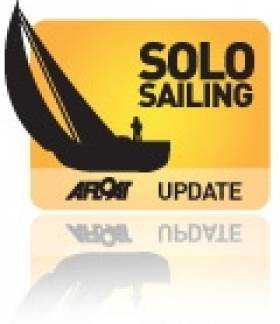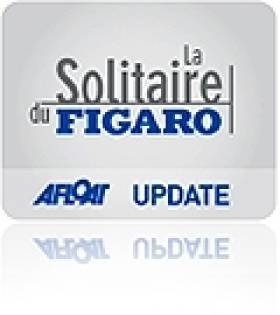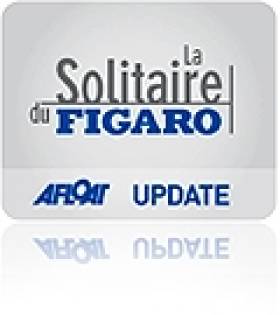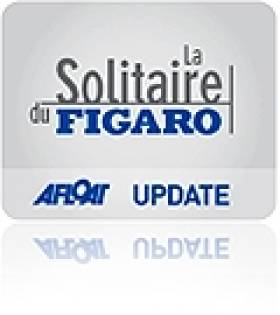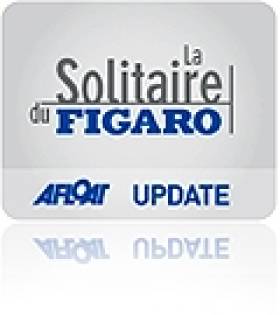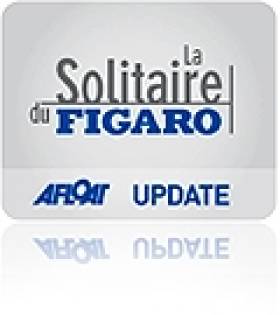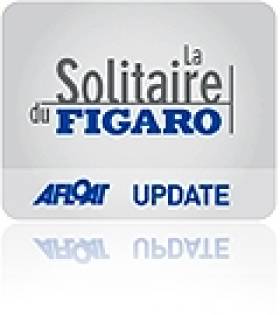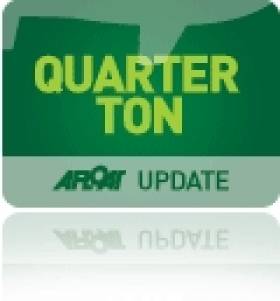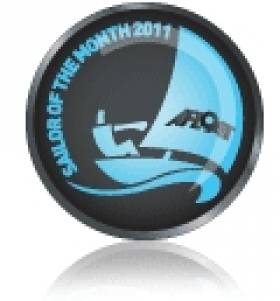Displaying items by tag: Kenefick
Kenefick Off to Good Start in Tour de Bretagne ala Voile
#fullirish – Cork Figaro single–hander David Kenefick is13th overall in a 23–boat fleet in the first leg of the Tour de Bretagne ala Voile that began today in Western France. The race is a double-handed race with inshore and offshore components. Kenefick is sailing with Jeanne Gregoire, an experienced French sailor that has completed nine La Solitaire du Figaro with her best result been a fifth overall.
23 Figaro's on the start with most of the fleet from La Solitaire competing, including some past America's cup skippers, multiple past winners of the Solitaire du Figaro Olympic medalists and match racing world champions.
David Kenefick sailing FULL IRISH finished the 30-boat Solo Concarneau in 15th place and second Rookie late yesterday evening. He now has just three weks to the start of the Solitaire du Figaro in Bordeaux and will now travel home to Cork for some R&R. We caught up with him shortly after he finished to hear how the race went.
"I've now finished my third race and I now know a lot more about what this kind of racing is."
"I was often in the front bunch but lost a little on the run, which put me on the back foot needing to do more to stay in the right places and not being able to pace myself with the leading boats. But I made the right call after Chausée de Sein and stayed further west in more pressure than the leading boats in shore and got back into the race there. This was satisfying. There was a certain amount of risk management coming into play there, something I learnt about in the previous race the Solo Arrimer the hard way and something some of my colleagues learnt more about this time!!!"
"We had three fronts go over us during this race. We had a lot of rain. An important thing here was to be able to know which rain shower was a new front coming over requiring a headsail change and which rain shower was benign. At night it was obviously harder, but I think I got the timing right for most of that gaining a couple of places in the process."
"I was happy with my speed, I was happy to be able to makes gains as well as losses, I was happy with the way I managed the boat."
"I slept four naps in the morning and four in the and the afternoon, eight minutes each. I probably got 90 minutes total during the whole race. I know I nodded off when I was helming a few times. That is horrible. It's dreadful."
"When I was at the lowest point emotionally at 04:00 I had to do something dramatic. More food, sugary things to get you through the darkest part until the dawn comes and suddenly life gets good again!"
"It is about training your mind. Your eyes will close but your mind is still going. Several times when I was awake again I had to go and check that what I'd been thinking about when I was in 'eyes closed' didn't actually happen. For example I think I dreamt that I tacked the boat or that I worked out that I'd filled the wrong ballast tank. Its hard to believe your mind can do that, there is no solution to it other than to understand that this will happen if you don't pace yourself properly. You have to go there to understand it. Its weird waking up when you are at the helm. Its quite amazing what your body and mind can do."
"I know my friend Ed Hill hit the 'red zone' big time in this race and was hallucinating and passing out. It cost him a lot of time and places and spoilt his race. He was doing really well but finished second last in the end. I think we all have to start to understand the priorities of these things and it not just about sailing the perfect first beat but much more about being lucid and fairly sharp after three days and three nights at sea, and for the Figaro, in a position to recover in time for the next leg too."
"I really hope I can do four of these races back to back. My objective here was to get back to the dock and be almost broken. I knew that I have two weeks to recover from this race and I needed to see what I can do when in that state and what it feels like."
"The first leg of the Figaro is probably the toughest. A lot will depend on this leg going well. Its 540-miles long, complicated at the start and its going to be really important to manage myself on the fatigue front on that one as the consequences for the following three legs, if I get it wrong, are big."
SOLO CONCARNEAU Results
1 20h01'50'' MEILHAT Paul SKIPPER MACIF 2011
2 20h14'15'' LUNVEN Nicolas GENERALI
3 20h17'13'' LE CLEAC'H Armel BANQUE POPULAIRE
4 20h20'00 ELIES Yann GROUPE QUEGUINER LEUCEMIE ESPOIR
5 20h34'00 VILLION Julien SEIXO HABITAT
6 20h37'50'' RUYANT Thomas DESTINATION DUNKERQUE
7 20h39'15'' MACAIRE Xavier SKIPPER HERAULT
8 20h39'58'' DESJOYEAUX Michel T.B.S.
9 20h49'30'' BOMBY Henry Christine
10 20h50'22'' JOSSIER Nicolas IN EXTENSO experts comptables
11 CHABAGNY Thierry GEDIMAT
12 RIVET Frédéric D.F.D.S. Seaways
13 PRUVOT Claire PORT DE CAEN-OUISTREHAM
14 CHERRY Nick ARTEMIS 23
15 KENEFICK David FULL IRISH
16 GOODCHILD Sam SCHELTER BOX DISASTER RELIEF
17 BOUTTEL Jack ARTEMIS 77
18 HOCHARD Benoît IB - MARKETING
19 AHRWEILLER Joan Région BASSE NORMANDIE
20 HILL Edmund ARTEMIS 37
21 Le Baud Gilles Thalasso
(Nine boats retired)
#kenefick – The night has passed and the fleet has now rounded Ile d'Yeu at the Southern most end of the course and are on the long leg North. The winds are now fresher blowing at 20 knots from the South West. The fleet will be under big spinnaker roaring along. We can see the speeds on AIS are hovering around the 9-10 knots.
The accuracy of the ranking taken this morning as the fleet rounded the island is not as reliable as the one at Birvideaux last night but still nevertheless a good indicator. The general order has been respected although there are a few climbers and droppers. After the second night at sea fatigue is certainly taking its toll. Some of the skippers have dropped down the ranking a bit and the sign of strength is to be able to make places and pick people off towards the end of the race. Overnight the number of boats and the time between David Kenefick and first Rookie Claire Pruvot has dropped and David is now just one place and seven minutes behind her. The published provisional rankings show him in 14th place which is probably accurate to within one place as the AIS on one of the boats we know to be ahead of him hasn't shown up. But it is close and there are four other boats within five minutes of him just behind.
With about 90 miles left to sail the wind is forecast to slowly head them all day and they may well finish this leg on the wind. ETA at the finish line is still late evening today.
1 5H56 MEILHAT Paul SKIPPER MACIF 2011
2 6H02 LE CLEAC'H Armel BANQUE POPULAIRE
3 6H02 ELIES Yann GROUPE QUEGUINER LEUCEMIE ESPOIR
4 6H04 LUNVEN Nicolas GENERALI
5 6H13 RUYANT Thomas DESTINATION DUNKERQUE
6 6H12 JOSSIER Nicolas IN EXTENSO experts comptables
7 6H12 BOMBY Henry Christine
8 6H13 RIVET Frédéric D.F.D.S. Seaways
9 6H15 DESJOYEAUX Michel T.B.S.
10 6H17 VILLION Julien SEIXO HABITAT
11 6H24 MACAIRE Xavier SKIPPER HERAULT
12 6H28 CHABAGNY Thierry GEDIMAT
13 6H33 PRUVOT Claire PORT DE CAEN-OUISTREHAM
14 6H40 KENEFICK David FULL IRISH
15 6H43 AHRWEILLER Joan Région BASSE NORMANDIE
16 6H43 HOCHARD Benoît IB - MARKETING
17 6H45 BOUTTEL Jack ARTEMIS 77
18 6H45 GOODCHILD Sam SCHELTER BOX DISASTER RELIEF
19 7H02 HILL Edmund ARTEMIS 37
20 7H50 LE BAUD Gilles CARNAC THALASSO & SPA
NON REPERE AIS _CONTACT RADIO CHERRY Nick ARTEMIS 23
NON REPERE AIS BIARNES Vincent PRATI'BUCHES
#figaro – When we updated you yesterday about the Solo Concarneau Figaro race that David Kenefick is competing in we bemoaned the lack of a tracker for this race but outlined that we would have a half way stage update. Here it is:
1 20h28 ELIES Yann GROUPE QUEGUINER LEUCEMIE ESPOIR
2 20h30 LE CLEAC'H Armel BANQUE POPULAIRE
3 20h31 LUNVEN Nicolas GENERALI
4 20h32 MEILHAT Paul SKIPPER MACIF 2011
5 20h36 BIARNES Vincent PRATI'BUCHES
6 20h36 DESJOYEAUX Michel T.B.S.
7 20h38 RIVET Frédéric D.F.D.S. Seaways
8 20h40 RUYANT Thomas DESTINATION DUNKERQUE
9 20h40 BOMBY Henry Christine
10 20h41 JOSSIER Nicolas IN EXTENSO experts comptables
11 20h50 VILLION Julien SEIXO HABITAT
12 20h56 MACAIRE Xavier SKIPPER HERAULT
13 20h58 PRUVOT Claire PORT DE CAEN-OUISTREHAM
14 21h03 HILL Edmund ARTEMIS
15 21h04 HOCHARD Benoît IB - MARKETING
16 21h14 CHABAGNY Thierry GEDIMAT
17 21h15 KENEFICK David FULL IRISH
18 21h17 AHRWEILLER Joan Région BASSE NORMANDIE
19 21h33 CHERRY Nick ARTEMIS
20 21h39 BOUTTEL Jack ARTEMIS
21 21h51 GOODCHILD Sam Vasco de Gama
22 22h16 LE BAUD Gilles CARNAC THALASSO & SPA
You might be wondering where some of the big names got to like Jeremy Beyou, Morgan Lagraviere and Fred Duthil. Well they were the leaders on Tuesday morning and as the day progressed their leading role saw them sail down a one-way alley whilst the boats behind anticipated better or just knew better and stayed further offshore and sailed around the outside in better breeze. To cut a lot story short when the two groups came back together there was a five mile deficit... Some of those now disgruntled top boats then chose to retire rather than fight their way back into the competition. Not a great look and maybe rather poor sportsmanship!
David Kenefick chose the right option and has been sailing with other boats all day and as we can see from the half way report is in 17th place. He is third Rookie being bettered currently by Claire Pruvot (13th) and Ed Hill (14th) by 17 and 12 minutes respectively. The race leader is last year's Solitaire du Figaro race winner Yann Elies who rounded 47 minutes ahead of David.
The course now takes the fleet South upwind in 15-30 knots of wind in heavy rain to round Ile d'Yeu 65 miles away before the long 105 mile reach home to Concarneau. The leading boats are expected to finish late on Wednesday evening.
When you run a race of the calibre of the Solo Concarneau without a tracking system it is extremely frustrating to try and work out what is really going on writes Marcus Hutchinson, team manager to David Kenefick.
There will be only two accurate rankings for the fleet taken with the race committee, one will be at the Brivideaux lighthouse that the fleet will probably reach late this afternoon or early evening and the second is obviously the finish line where we expect to have the leaders approaching late afternoon on Wednesday. There are some other provisional rankings established using the coastguard radar stations supplemented with the competitors all calling in after they have gone round but as one can imagine these aren't particularly reliable. Then there is the AIS system.
The racing names of the boats and the registered names to the AIS systems are not the same so a look up sheet is required to identify who is who.
Then it doesn't ever update all the boats' positions at the same time, and it really only works for fleet following when the fleet is near a powerful radar station, of which there are several along the coast in France. But there are also many areas that just aren't covered, probably 60-70% in total.
So to cut a long story short when we left David Kenefick and his Full Irish yesterday he was sailing in 8 knots of wind, in 9th place and heading towards the Raz de Sein with his spinnaker set. The ranking published this morning had him in 23rd at the most Northerly mark, effectively the leeward mark. But it isn't to be trusted too much. The reason for this is that boats that were behind him on the ranking that do appear on the AIS are placed in the leading pack, pretty much where they were when we left them last night. David's AIS is not showing up, if you see a boat called Ilidian that is him.
The fleet is on the wind right now in about 10 knots of wind beating towards the Pointe de Pen March. The next significant mark on the course is the Brivideaux lighthouse just near the Quiberon Penninsula where we will get a decent committee boat generated ranking sometime late this afternoon.
#figaro – Exhausted but elated to have secured his place for June's Solitaire du Figaro race, 22–year–old Cork sailor David Kenefick talked to Afloat.ie on completing his longest race to date, the 320–mile Solo Arrimer this morning.
The Crosshaven rookie who finished 21st in the 25-boat fleet admits in this podcast there is plenty of room for improvement before his debut in the French multi-leg offshore race in two month's time.
The world-renowned Figaro comprises of four legs of approximately 400-500 miles single handed starting from Bordeaux in early June 2013 against 35 other skippers all using identical equipment. Kenefick, one of eight rookies in the race will be Ireland's sole entry.
British solo offshore sailing took a step in the right direction this weekend, as three Anglo-Saxon Figaro skippers conquered the Rookie podium. Storming the 305-mile Solo Arrimer finish line at around 23:30 BST on Friday 12th April, 22 year old Artemis Offshore Academy sailor Jack Bouttell claimed the Rookie podium top spot, finishing 16th overall out of field of 26 sailors packed with talent. The next Artemis Rookie over the line was Ed Hill, who stepped up on the podium behind comrade Jack to take second, a great achievement and confidence boost for both British Academy sailors in only the second solo race of their careers.
Completing the Anglo Rookie trio was Irish Figaro sailor David Kenefick, who finished 21st overall behind Ed in 20th.
The British and Irish invasion left no room for the French on the up-and-coming Rookie podium, and with six fresh faced and eager to prove Anglo talents now racing on the circuit, could the French-dominated tide of the Figaro Class slowly be on the turn?
"I think my race went well. I had good boat speed at times and in general I'm happy with my performance and result," reported Jack after finishing the race, his happiness breaking through the exhaustion. "My highs for the race were finishing, of course, and just launching the boat downwind over the big Bay of Biscay waves in 30-40 knots of wind." Watch Jack's post race interview here.
"Jack sailed a consistent and intelligent race the whole way round the course" said event coach Marcus Hutchinson. "He told me afterwards that the way he keeps going and motivated in the darkest moments is to eat more. I think Jack consumes three or four times as much food on these races than anyone else. But if it works for him, then we'll find the food!" Read Marcus' Solo Arrimer race wrap up here.
Conditions for the 36-hour race were heinous and the course starting and finishing in Les Sables d'Olonne was shortened slightly to 305 miles. Wind speeds built from 6 knots for the start to a howling 40+ knots through the night combined with a 3 to 4 meter swell, ensuring that the sailors' first Atlantic race of 2013 was a real solo offshore challenge.
"The weary, but crazed eyes of all the skippers as we tucked into soup and crepes after the finish just said it all," reported Academy graduate Henry Bomby. "We all knew we had experienced something pretty cool during this race, something that not everyone will get to ever experience." Read the Academy sailors' war stories here.
Five British sailors lined up for the Solo Arrimer alongside a festival of Figaro rock stars. Academy graduates Henry and Nick Cherry, along with Ed, battled it out to finish within minutes of one another, with Henry just pipping them both to the finish line in 18th, improving on his 2012 result by 10 places. Now in his third year in the Figaro Class, Sam Goodchild was the first British boat over the line, just missing out on a top ten spot in 11th, to finish 50 minutes behind winner Morgan Lagraviére, and just ahead of the 'Professeur' himself, Michel Desjoyeaux, who makes his return to the Figaro after four years away.
"The race was a lot of fun, but at the same time incredibly challenging," Sam admitted. "We had some of the worst weather conditions I have ever seen in a race. But I put up a good fight and I'm happy with my result. It's encouraging to know I'm not too far off the pace."
Solo Arrimer winner Morgan, a French Olympic 49er sailor, finished the race in 1 day, 9 hours, 40 minutes and 43 seconds, just 13 minutes ahead of second skipper Thierry Chabagny. Yann Eliés, 2012 Solitaire du Figaro winner, came through the harsh Atlantic conditions to take third.
"During the Solo Arrimer all of the skippers proved they can safely get their boats around the course, race, navigate and bring it home in terrible conditions, there is no need to be too clever when being intelligent is enough. The strong winds and white water battering the sailors and their boats for the duration of the Solo Arrimer were not only a test of the solo skippers' metal, but of their stamina, performance and self management," concluded Marcus. "This weekend's podium results will come as a huge morale and psychological boost for both Ed and Jack in training and ahead of their next race, but that was just 30 odd hours, we've still got a lot of work to do in preparation for the 1,938 miles of intense racing that is the Solitaire du Figaro."
After celebrating his first Figaro Rookie class win by popping his first bottle of Pol Roger on the pontoon, Jack, along with Ed and Nick set sail straight away for Concarneau, France where they will now spend the next three weeks training and preparing with event coach Marcus for the Solo Concarneau starting May 6th, as well as their boats getting a refit so they are ready, if selected, to be on the Solitaire start line in June.
Solo Arrimer overall results
Position/Skipper (Boat name) Time at sea
1. Morgan Lagravière (Vendée) - 1 day 9hours 40min 43sec
2 .Thierry Chabagny (Gedimat) - 1 day 9hours 53min 45sec
3. Yann Elies (Group Queguiner Leukemia Hope) - 1 day 9hours 55min 14sec
4. Nicolas Lunven (Generali) - 1 day 10 hours 38sec
5. Jeremiah Beyou (Master Chef) - 1 day 10hours 02min
6. Xavier Macaire (Skipper Hérault) - 1 day 10hours 4min 40sec
7. Armel Le Cléac'h (Banque Populaire) - 1 day 10hours 19min 5sec
8. Frédéric Duthil (Sepalumic) - 1 day 10hours 26min 56sec
9. Alexis Loison (Group Fiva) - 1 day 10hours 27min 25sec
10. Jean-Pierre Nicol (Bernard Controls) - 1 day 10hours 27min 27sec
11. Sam Goodchild (Shelter Box) - 1 day 10hours 30min 45sec
12. Meilhat Paul (Macif) - 1 day 10hours 35min 50sec
13. Michel Desjoyeaux (TBS) - 1 day 10hours 41min 07sec
14. Julien Villion (Seixo Habitat) - 1 day 10hours 42min 6sec
15. Frédéric Rivet (DFDS Seaways) - 1 day 10hours 48min 48sec
16. Jackson Bouttell (Artemis 77) - 1 day 10hours 50min 31sec
17. Matthew Girolet (Lafont Presse) - 1 day 10hours 51min 35sec
18. Henry Bomby (Zhik - Made for Water ) - 1 day 10hours 57min 23sec
19. Nicholas Cherry (Artemis 23) - 1 day 11hours 14min 29sec
20. Ed Hill (Artemis 37) - 1 day 11hours 33min 35sec
21. David Kenefick (Full Irish) - 1 day 11hours 48min 26sec
22. Claire Pruvost (Port de Caen Ouistream) - 1 day 12hours 36min 35sec
23. Joan Ahrweiller ( Basse Normandie) - 1 day 12hours 38min 24sec and
24. Yannig Livory (Thermacote France) - 1 day 12hours 43min 19sec and
25. Gilles Le Baud (Carnac Thalasso & Spa) - 1 day 13hours 49 min 53 sec
26. Benoit Hochart (Aquarius) - 1 day 13hours 55min 55 sec
#figaro – If solo sailor David Kenefick successfully completes completes tomorrow's 'Lien Cartographie Solo Arrimer' race he officially qualifies for this Summer's Figaro race, a long held ambition for the young Munster sailor.
LIVE TRACK DAVID KENEFICK's PROGRESS
The race at 320nm miles is the longest the Crosshaven sailor will have completed to date in his boat Aquarius. He's also lining up against the best French skippers (See below for entry list)
Organised by the Water Sports Sablais since 2003 Sables d'Olonne, the Solo STOW runs between the islands of Ré, Yeu and Belle-Ile on the French West Coast.
While a large depression, accompanied by high winds, is poised to sweep west over France today, the weather files show a weaker low pressure system from Thursday.
There will be plenty of competition from previous Vendee Globe sailors plus he's also racing against Michel Desjoyeaux, (a three time Figaro winner) and (two time Vendee globe winner) but the Irish sailor says he has something of an advantage in that he is in Desjoyeaux's old boat after chartering it for the year!
Full list of entries below:
Joan Ahrweiller / REGION NORMANDY, Jeremiah BEYOU / MASTER COCK, Henry Bomby / Zhik - MADE FOR WATER, Jack Bouttell / ARTEMIS 77; Thierry Chabagny / GEDIMAT, Nick CHERRY / ARTEMIS 23; Michel DESJOYEAUX / TBS; Frédéric DUTHIL / Sepalumic; Yann ELIES / GROUP QUEGUINER LEUKEMIA HOPE, Matthew GIROLET / LAFONT PRESS, Sam GOODCHILD / VASCO DE GAMA, Edmund HILL / ARTEMIS 37; Benoit HOCHART / AQUARIUS: David Kenefick / FULL IRISH; Morgan LAGRAVIERE / VENDEE; Gilles LE BAUD / Carnac Thalasso & SPA , Armel LE CLEAC'H / CREDIT; Yannig Livory / THERMACOTE France; Alexis Loison / Group FIVA Nicolas LUNVEN / GENERALI; Xavier MACAIRE / SKIPPER HERAULT, Paul Meilhat / SKIPPER MACIF 2011, Jean-Pierre Nicol / BERNARD CONTROLS, Claire PRUVOT / PORT DE CAEN OUISTREHAM; Frederic RIVET / DFDS SEAWAYS; Julien VILLION / Seixo HABITAT.
Update from David:
Well this is it. It's the night before the start of the Solo Arrimer Race. We are in Les Sables, in the Atlantic, with the tide and of course the beautiful, not, Spring weather. The pictures I posted on my facebook page two days ago were a freak window of sun and light winds before the rot set back in and it has been blowing over 30 knots ever since. Today it barely stopped raining. But that is the lot of a solo sailor. Get up and get on with it.
It's a long course they have set us, the longest I've sailed at 305 miles, but ironically it may end up being only 36 hours in duration as there is plenty of wind and it is mostly a reach up and down the French coast. We head initially South East to pass inside ile de Ré and under the bridge that joins it to the mainland by La Rochelle, before heading North all the way up inside Belle Isle to a mark just off the tip of the Quiberon Penninsula. We then return via Les Sables d'Olonne to round Ile de Ré again, but this time in the other direction before heading to the finish line again.
My objectives for the race are, number one to finish the race, number two to stay in touch with the legends that have also entered the race too for as long as possible, and three to gather as much experience as possible.
I've learnt this week about the unbelievable amount of preparation that goes into entering and being cleared to race. The amount of paperwork is unbelievable but all necessary. We have been working hard on weather and navigation briefings as the start time rolls closer and we have a better idea of what we will experience on the weather side and hence at what time and what state of the tide we will round the marks on the course. We have been checked by safety scrutineers, sail measurers, the press and of course Mathilde at the Class association has diligently helped us all with the certificates for this and that and the other ,... oh and the PLB battery expiration date!
Safety is a serious business and no one takes it lightly. I already appreciate more now than I did a week ago about why things are done the way they are done. Being in this environment for a week allows us to learn from the older and more experienced skippers about their preparation, what their priorities are and where our own preparation is lacking.
Anyway, now it's like the night before your final school exams. The revision has been done to a greater or lessor extent, there is not much more we can do except be fresh in the morning and go out and do it. The exam results should be known sometime in the small hours of Saturday morning when we cross the finish line here again in Les Sables d'Olonne.
Kenefick Sucessfully Defends Quarter Ton Crown in Cowes
#quarterton – In the Corinthian Division of the Quarter Ton Cup for all-amateur crews Afloat's Irish Sailor of the Year George Kenefick sailed Tiger, the 1989 Fauroux design he owns jointly with his father Neil, to victory ahead of Sergeant Pepper, Richard and Anne Thomas's Bolero, which was designed by Richard's father David.
Third place went to Paul Kelsey's Runaway Bus, a 1977 Whiting design, with Love In A Mist, a 1974 Waarschip owned by Eric and Philip Williams - the oldest boat in the regatta - fourth.
As close finishes go the final day of the Coutts Quarter Ton Cup 2012 was certainly up there with the best of them. Going into the day Peter "Morty" Morton's 1978 Fauroux had a three-point lead over Sam Laidlaw's 1990 Vrolick designed Aquila, being helmed today by John Greenwood. Anchor Challenge, a 1978 Farr design helmed by Paul Gibbons, was six points back in third on 40 points with Alice II, Rickard Melander's 1990 Morrison, lying in fourth on 49. The first race of the day, the seventh of the nine race series, saw the discard come into play and with several of the top boats counting a black flag disqualification from race six there was plenty of room for manoeuvre in the final rankings.
Race Officer Rob Lamb and his Committee, the core of which will be officiating on the RSX course at the Olympic Regatta in Weymouth, did an excellent job to complete the final three races scheduled despite very variable breeze. The unpredictable wind and a strong tide gave the sailors plenty to think about and ensured the fleet was constantly shuffling places with surprises and dramas at every turn.
Race seven set the tone of high drama when a number of teams misjudged the strength of the tide, resulting in a series of mark one pileups. After that the day just got more and more exciting with some of the closest racing you could hope to see anywhere in the world.
Despite being one of the boats caught up in the race seven mark rounding debacle, ultimately Peter Morton and his crew claimed a record third Coutts Quarter Ton Cup win by just 4 points from Alice II with Aguila third and Anchor Challenge fourth. This achievement was impressive not only because it was the first time the event has been won by the same person three times but also because Peter and his team have used three different boats for their wins.
The racing results only tell part of the story of the Coutts Quarter Ton Cup, which is as much about the fun of finding and loving these very special historic little boats and sailing with your old mates, as it is about winning. A quick look around the fleet reveals that what ever the age of boat, whether she's been professionally restored or is lovingly maintained by her owner and crew, each is a little masterpiece in her own way. Many of today's leading designers cut their creative teeth in the class. The boats have character, they're quirky, some of them are downright strange to look at, but they all entrance both their owners and those who sail them.
There are a couple of very special boat mentions to make in this report. The first is Atalanti IV, owned by past ISAF Vice Chairman and sailing legend George Andreadis. George commissioned Atalanti IV for the 1991 Quarter Ton Cup. Design by Rob Humphries the boat ran late and only arrived just in time for the event where she finished fourth. Having completed that '91 Cup George then put the boat into storage in his infamous Athen's boat shed and never sailed her again. Until that is, Morty persuaded him to bring her out of retirement for the 2012 Coutts Quarter Ton Cup. A good wash and brush up later and not only did she finish a very creditable eighth but she was also chosen as winner of this year's Marineware's Concourse d'Elegance, for the best-presented yacht at the regatta.
The other special mention has to go to Freres-sur-Mer, a 1981 Fauroux design owned by Holland's Theo and Andre Bakker. This was her first ever Coutts Quarter Ton Cup and the boys threw themselves into the spirit of the event with gusto. Whilst they may have finished in last place their results were somewhat hampered by a black flag and two did not starts on the first day courtesy of a broken traveller. The fact that they are still sailing with a 1984 mainsail might just have had something to do with it too! It was wonderful to have them join the fleet and at the prize giving they were presented with a roll of duct tape to help with running repairs and a packet of handy Solent navigation chart napkins to ensure they can find their way back for the 2013 event.
A look around the crews is revealing too as the fleet without doubt attracts some of the best sailors in the world. Not for big money, but because they want to sail with their mates and they too love Quarter Tonners. This year's rogues gallery included the likes of World Match Racing Champion Ian Williams, America's Cup veterans Don McCracken, Dave Scott, Ethan Bixby, British Olympians Stuart Childerley and Andy Beadsworth, David Howlett, Kelvin Rawlings, Jason Carrington, Ian Southworth, David Bedford, John Greenwood, Mike Budd, John Brinkers, Nigel Young, Irish Olympian Mark Mansfield...... and the list goes on.
Once again a fleet of sailors has gone home at the end of the Coutts Quarter Ton Cup with a sense of achievement, lots of like-minded new friends and some wonderful memories. Our thanks go to event sponsor Coutts for their most generous long-term support of the event, to Class Secretary Louise Morton for her tireless work in making the regatta happen, to the Race Committee and to the members and staff of the Royal Corinthian Yacht Club.
There are still Quarter Tonners out there in need of a good home so if you feel you could give a down at heel Quarter Tonner the love and attention she needs please contact Quarter Ton Class Secretary Louise Morton on [email protected] who manages our rehoming programme.
Another Quarter Tonner Comes up for Sale
#BOATS FOR SALE – A Quarter Ton yacht for sale at €8,000 is 'a great club racer' that 'normally cleans up in Class 3', that's according to a new advertisment on Afloat's Boats for Sale site this morning. The yacht Manzanita has been 'reduced to sell' by owner George Kenefick, the recently crowned All Ireland Sailing Champion.
Earlier this month a similar yacht, a Bolero 26, Bandit, sold quickly prompting seller Ian Travers to write and record his thanks for the interest generated from the advert on the Afloat boats for sale site (cost €10).
Quarter Ton racing looks like a popular style of sailing for the current times. A leading example, Supernova took top prize at this year's Volvo Dun Laoghaire Regatta and both the 2011 ICRA Nationals and the Sovereign's Cup championed the small boat cause.
The latest addition to the boats for sale site is 'a steal for the price' says Kenefick who makes the 1977 vintage craft sound like an ideal winter project for a Dublin Bay or Cork Harbour campaign in 2012.
The boat had a new 'Formula' rig in 2006 and new mainsheet track in 2008 with new Harken cam cleats.
The boat was resprayed in 2005 but now needs a few touch ups.
All sails are from McWilliam Sailmakers. A mast head kite and a small kite are inlcuded.
The boat is lying in Hamble UK on a Trailer but you can see photos of her on the full advert here.
George Kenefick is October's Sailor of the Month
The 23-year-old helmsman won the Quarter Ton Classics Corinthian Division in July with his immaculately-restored boat Tiger, racing against a top lineup in the Solent. That performance saw him recruited to helm the English-owned boat Chimp in the Half Ton Worlds at the same venue in August. Kenefick showed the quality of his abilities by interacting with a crew he'd never sailed with before to become overall winner against an impressive international fleet.
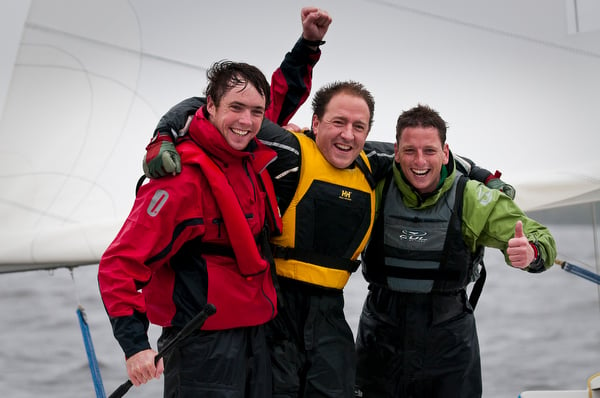
George Kenefick, Mel Collins and John Downey celebrate their win on Lough Derg. Photo: Brendan Fogarty
Back in home waters, next up was the Waterways Ireland ISA National Championship on Lough Derg in the ISA's SailFleet flotilla of J/80s at the beginning of October. For this series Kenefick recruited Crosshaven clubmates John Downey and Mel Collins as crew. The opposition included former champion Mark Mansfield, who had returned to competitive sailing by winning the 1720 Europeans in Baltimore against a fleet including Anthony and Nicholas O'Leary, both former Irish Open Champions.
It went right down to the wire, with Mansfield and O'Leary emerging well ahead on 12–points apiece. On the countback, Kenefick was the new champion. Almost immediately, he was back in the thick of logistics and personnel organization in taking the Cork Institute of Technology sailing team to France for the Student Worlds, CIT representing Ireland as winners of our national series.
With sixteen college teams from all over the world, even in resources-rich French sailing the organizers were stretched in finding an evenly-matched fleet of sixteen Archambault keelboats. There were top class new boats, but some not so new boats, and a trio of boats well past their sell-by date. It was all in the luck of the draw, and the Irish and much-fancied Portuguese found themselves drawing the shortest straw.
In a demanding series, the Portuguese were never at the races with their tired mount, but the Irish simply refused to give up despite a boat which, with its equipment, was falling apart. There was ample opportunity to do this, as the series in the Bay of Biscay off La Trinite included some really rough stuff. In fact, the Irish revelled in the strong breeze, but in the light airs which settled in as the week drew on, it took pure skill.
By the final races last Saturday, they'd got themselves an unassailable third position, but the two British teams – defending champions are allowed an extra place – had miscalculated the points situation. So on the final day, they team raced, one of their boats sailing the Irish crew down the fleet in the best Ben Ainslie style. It was the first time Ireland had finished outside the top six, but they still had the bronze, the Brits took silver, and the French were well ahead to win overall.
More from WM Nixon in the Irish Independent here




























